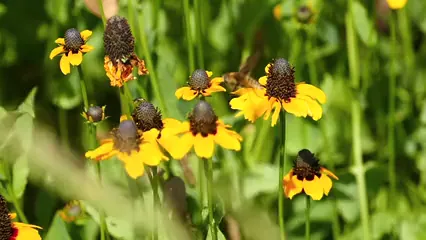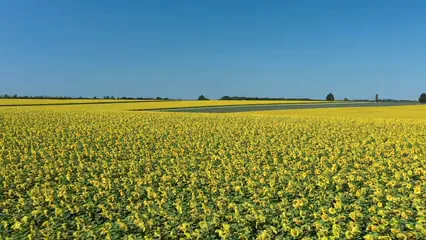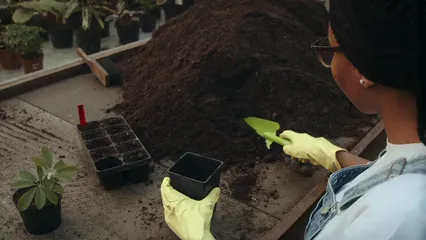

Compass Plant in Michigan: A Comprehensive Guide
Introduction
The compass plant (Silphium laciniatum) holds a special place in Michigan’s ecosystems. This striking perennial is known for its tall stature and unique leaf orientation. Native to prairies and open woodlands, it thrives in Michigan’s rich biodiversity. In this article, we’ll cover how to identify compass plants, their care requirements, benefits, and their ecological significance.
If you’re looking to get started with your own garden, why not check out some handy gardening gloves? They will keep your hands safe and clean while you dig into the soil, making gardening a much more pleasant experience!
Summary and Overview
Compass plants are native to Central North America, including Michigan. They grow tall, reaching heights of 5 to 12 feet, with bright yellow flowers blooming from mid-summer to early fall. These plants play a vital role in attracting pollinators like bees and butterflies. In this guide, you’ll learn about their identification, care, and the many benefits they offer to both gardens and local wildlife.
And while you’re at it, consider enriching your soil with some organic fertilizer. It’s like a multivitamin for your plants, ensuring they have all the nutrients they need to thrive!

The Compass Plant: An Introduction
The compass plant, scientifically referred to as Silphium laciniatum, belongs to the Asteraceae family. This native plant is fascinating due to its historical significance and unique growth traits. Its name comes from the way its basal leaves align north to south, maximizing sunlight exposure. This orientation helps the plant thrive in sunny environments, making it a remarkable addition to any garden.
Compass plants can grow anywhere from 5 to 12 feet tall, showcasing large, deeply lobed leaves that can reach lengths of 20 inches. They bloom from July to September, producing sunflower-like flowers that add vibrant color to the landscape. These characteristics make the compass plant an excellent choice for anyone looking to enhance their garden with native flora. Why not consider planting compass plants in your own garden?

Identification and Characteristics
Physical Appearance
Compass plants are easily recognizable due to their impressive height, typically ranging from 5 to 12 feet. Their large basal leaves are deeply lobed and can be 10 to 20 inches long. The upper leaves are smaller and less lobed. The plant’s stem is sturdy and light green, often covered in fine hairs.
In mid-summer, the compass plant produces striking yellow flowers that resemble sunflowers. Each flower can grow up to 5 inches in diameter, with a central disc surrounded by ray florets. These blooms are arranged in loose clusters at the top of the stem, creating a stunning display. As you explore local parks, take the time to identify these unique plants and appreciate their beauty.

Habitat and Growing Conditions
Compass plants thrive in Michigan’s diverse ecosystems, preferring well-drained soils. They can adapt to various soil types, including sandy loam and clay. The ideal soil pH ranges from 6.0 to 8.0, making it suitable for many areas in the state. These plants are drought-tolerant, with a remarkable ability to withstand dry conditions once established.
Light is crucial for compass plants. They flourish in full sun, requiring at least six hours of direct sunlight daily. This exposure not only promotes growth but also enhances their vibrant yellow flowers during the summer months.
You’ll often find compass plants in prairies, roadsides, and open fields. Their tall stature and unique leaf orientation make them stand out in these habitats. If you’re considering planting them, it’s wise to test your soil for compatibility. This simple step ensures your compass plants will thrive in your garden. For more information on soil pH testing, check out soil pH testing and adjustment for optimal plant growth.
Understanding soil pH is crucial for the successful growth of compass plants and other native flora. Learn more about soil pH testing and adjustment.
And if you’re curious about how to enrich your garden further, consider a compost bin. Composting is a fantastic way to recycle kitchen scraps and yard waste into nutrient-rich soil amendments!

Ecological Importance
Role in the Ecosystem
Compass plants play a vital role in Michigan’s ecosystems. These stunning perennials attract a variety of pollinators, including bees and butterflies. Studies show that compass plants can increase pollinator visitation rates by up to 60%. This vibrant activity enhances local biodiversity and supports native ecosystems.
Moreover, compass plants provide essential habitat for local wildlife. Birds often perch on their tall stems, while insects find refuge among the large leaves. As a deep-rooted species, compass plants also contribute to soil health. Their extensive root systems improve soil structure and help retain moisture, making them beneficial for nearby plants. If you’re interested in creating a wildlife habitat, consider reading about how to create a backyard wildlife habitat.
Planting compass plants can significantly enhance your garden’s biodiversity and provide habitat for various wildlife species. Discover how to create a backyard wildlife habitat.
Uses in Landscaping
Compass plants can dramatically enhance your garden design. Their impressive height and bright yellow flowers create a striking focal point. When paired with other native plants, they contribute to a vibrant, colorful landscape. Consider companion planting with sunflower seeds or native grasses for stunning visual appeal. For more on companion planting strategies, check out companion planting strategies for increased yield.
Companion planting can enhance the growth and yield of your compass plants. Explore companion planting strategies.

These plants are also drought-resistant, making them perfect for sustainable landscaping. Their deep roots allow them to withstand dry spells, reducing the need for constant watering. For those interested in native gardening, compass plants offer an attractive solution that benefits the environment.
Speaking of sustainable gardening, consider using a garden hose with nozzle to make watering efficient and enjoyable!

If you have a compass plant garden, we would love to see it! Share your photos and inspire others to cultivate these beautiful plants in their own landscapes.
Challenges and Considerations
Common Pests and Diseases
Compass plants, while generally resilient, can face challenges from various pests and diseases. Common culprits include deer and rabbits, which often munch on young foliage. Their appetite can lead to significant damage, especially in newly established gardens. To protect your plants, consider using deer repellent spray or repellents to deter these hungry visitors.
In terms of diseases, compass plants are typically robust. However, they can occasionally suffer from fungal issues, particularly in overly wet conditions. If you notice yellowing leaves or wilting, it may be a sign of root rot. Treatment options include improving drainage and removing affected areas. Regular monitoring can help catch these problems early.
Local gardeners report that deer and rabbit damage is common, with some noting up to 30% loss in young plants. Implementing proper pest control measures and maintaining plant health through good practices can dramatically improve their chances. If you spot any pests in your garden, please report them. Your observations help in tracking and managing challenges for future compass plant success.

Conclusion
The compass plant is a significant asset to Michigan’s ecosystems. Its towering presence and vibrant blooms add beauty to any landscape while supporting local wildlife. These plants attract pollinators and contribute to the overall health of our environment. By considering the planting of compass plants in your garden, you can play a part in conservation and enjoy their aesthetic appeal.
Let’s work together to enhance biodiversity. Start your native plant journey today and transform your garden into a thriving habitat! For tips on native plants that attract local wildlife, check out Best native plants for attracting local wildlife.

FAQs
What is a compass plant?
The compass plant, scientifically known as *Silphium laciniatum*, is a striking perennial. It can grow between 5 to 12 feet tall. The plant features large, deeply lobed leaves that can reach 20 inches long. Its yellow flowers, resembling sunflowers, bloom from mid-summer to early fall. A unique trait of the compass plant is its basal leaves, which tend to align north-south. This orientation helps maximize sunlight exposure, aiding growth.
Where can I find compass plants in Michigan?
Compass plants can be spotted throughout Michigan, especially in prairies and open fields. Look for them in natural areas like the Barry State Forest and the Waterloo Recreation Area. Many native plant nurseries also stock compass plants. Consider visiting local spots like Wild Type Native Plant Nursery or Michigan Wildflower Farm for healthy specimens.
How do I care for a compass plant?
Caring for compass plants is relatively simple. They thrive in full sun, needing at least six hours of direct sunlight daily. Ensure the soil is well-drained, as these plants prefer slightly dry conditions once established. Water them moderately, especially during their first growing season. These plants are drought-resistant, so they won’t need much attention once they are established.
Can I grow compass plants from seeds?
Yes, you can grow compass plants from seeds! The seeds require cold stratification to germinate effectively. For best results, sow them in late winter or early spring. Plant the seeds in moist potting soil, ensuring they receive sunlight. Germination typically occurs within one to two weeks under suitable conditions. This process allows you to enjoy the beauty of compass plants in your own garden.
Why are compass plants important for pollinators?
Compass plants play a crucial role in supporting local pollinators. Their vibrant yellow flowers are a favorite among bees and butterflies. These plants provide nectar and pollen, essential for the survival of these beneficial insects. By planting compass plants, you can help attract and sustain pollinator populations, promoting a healthier ecosystem in your area.
While you’re at it, if you want to make sure your garden is thriving, grab a plant watering spike to automate your watering routine!
Please let us know what you think about our content by leaving a comment down below!
Thank you for reading till here 🙂
All images from Pexels



